

High school dietary dairy intake and teenage acne. Estrogen in Meat, Dairy, and Eggs. Prostate Cancer and Organic Milk vs. Almond Milk. Skim Milk and Acne. Skim Milk and Acne. The National Dairy Council denies that milk intake causes acne, but a study they supported—the Harvard Nurse’s Health Study—found otherwise, as I show in my 3-min. video National Dairy Council on Acne and Milk.

Adverse effects of cow's milk in infants. Diet in acne: further evidence for the role of nutrient signalling ... Milk and diabetes. Got Proof? Lack of Evidence for Milk's Benefits. There is no biological requirement for cow’s milk.
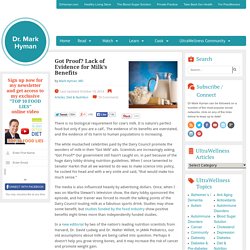
It is nature’s perfect food but only if you are a calf.. The evidence of its benefits are overstated, and the evidence of its harm to human populations is increasing. The white mustached celebrities paid by the Dairy Council promote the wonders of milk in their “Got Milk” ads. Scientists are increasingly asking, “Got Proof?” Our government still hasn’t caught on, in part because of the huge dairy lobby driving nutrition guidelines. The media is also influenced heavily by advertising dollars. In a new editorial by two of the nation’s leading nutrition scientists from Harvard, Dr. It is bad enough that the dairy industry recently petitioned the FDA to sneak artificial sweeteners into chocolate milk. What about low fat milk or non-fat milk? Studies show that reducing fat in the diet, which parallels an increase in starch and refined carbohydrates in the diet, not only increases hunger but also may actually slow metabolism.
Three Daily Servings of Reduced-Fat Milk: An Evidence-Based Recommendation? Milk Is Dangerous for Your Health. Our current government guidelines recommend drinking three glasses of milk a day for every American over five.
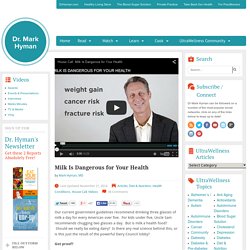
For kids under five, Uncle Sam recommends chugging two glasses a day. But is milk a health food? Should we really be eating dairy? Is there any real science behind this, or is this just the result of the powerful Dairy Council lobby? Got proof? I recently wrote a blog called Got Proof? So, is milk nature’s perfect food? Dairy should not be a dietary staple While it is true that some people can tolerate dairy in small amounts—for example, descendants from Northern Europe and people who don’t have allergies, lactose intolerance, or a leaky gut—it should not be a staple of our diet. Dairy contains some very allergenic proteins, such as casein, which can be problematic for many people. If you want to eat dairy, I suggest you try goat and sheep dairy, such as sheep cheese and yogurt or goat cheese and yogurt, both of which are widely available now.
Cow milk feeding in infancy: further observations on blood loss fro... 18 Surprising Dairy-Free Sources of Calcium. You Might Like {{displayTitle}} READ Fun fact: Calcium is the most abundant mineral in the body, and is found naturally in a wide variety of foods and beverages and added to many others!
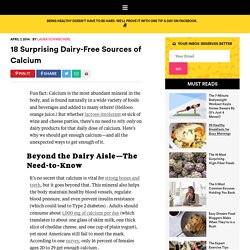
(Hellooo orange juice.) But whether lactose-intolerant or sick of wine and cheese parties, there’s no need to rely only on dairy products for that daily dose of calcium. Here’s why we should get enough calcium—and all the unexpected ways to get enough of it. Beyond the Dairy Aisle—The Need-to-Know It’s no secret that calcium is vital for strong bones and teeth, but it goes beyond that. The main calcium contenders are milk, yogurt, and cheese, but dairy shouldn’t be the only dietary pit stop to fill up on this nutrient. Craving Calcium? Milk intake and risk of mortality and fractures in women and men: cohort studies. Abstract Objective To examine whether high milk consumption is associated with mortality and fractures in women and men.
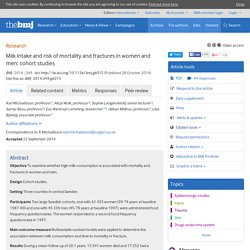
Design Cohort studies. Setting Three counties in central Sweden. Participants Two large Swedish cohorts, one with 61 433 women (39-74 years at baseline 1987-90) and one with 45 339 men (45-79 years at baseline 1997), were administered food frequency questionnaires. The women responded to a second food frequency questionnaire in 1997. Main outcome measure Multivariable survival models were applied to determine the association between milk consumption and time to mortality or fracture.
Results During a mean follow-up of 20.1 years, 15 541 women died and 17 252 had a fracture, of whom 4259 had a hip fracture. Dietary Supplement Fact Sheet: Calcium. Introduction See Consumer for easy-to-read facts about Calcium.
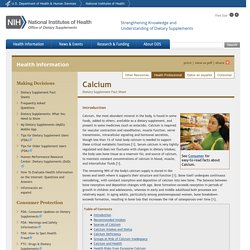
Calcium, the most abundant mineral in the body, is found in some foods, added to others, available as a dietary supplement, and present in some medicines (such as antacids). Calcium is required for vascular contraction and vasodilation, muscle function, nerve transmission, intracellular signaling and hormonal secretion, though less than 1% of total body calcium is needed to support these critical metabolic functions [1]. Page. What you need to know about calcium. Home > Welcome Newsweek readers Harvard Health Letter, April 2003 Calcium is billed as the bone-building nutrient.
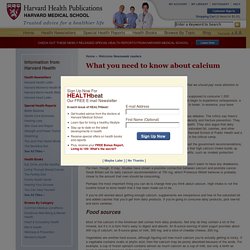
But some experts argue that we should pay more attention to exercise and vitamin D. Starting on your 51st birthday, current government guidelines say you’re supposed to consume 1,200 milligrams (mg) of calcium daily. At about that age, both men and women begin to experience osteoporosis, a decline in the density of bones that makes them weaker and more likely to break. But calcium is currently at the center of one of nutrition’s most contentious debates. Naturally, the proponents see the evidence quite differently — and they set the government recommendations, so they’re hardly a fringe group. So what should you do? Perhaps the most important thing you can do is change how you think about calcium.